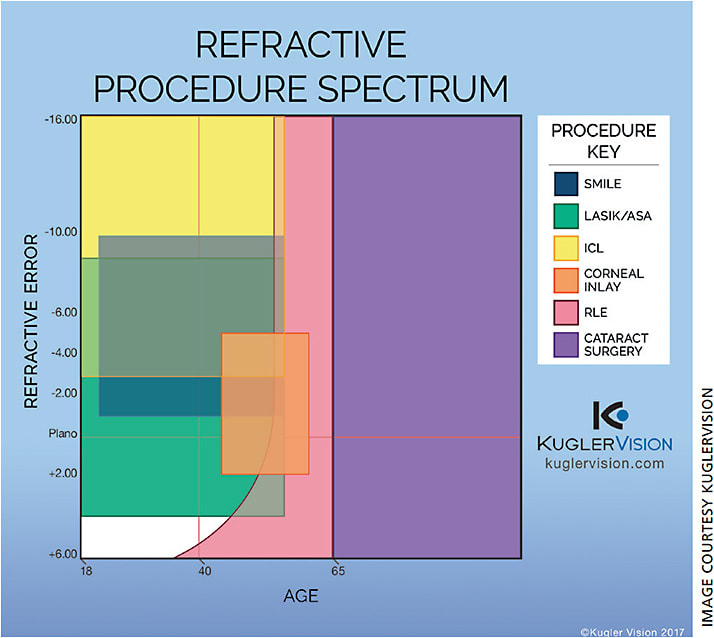Refractive surgery is on the rebound. The reasons: the variety of technologies and procedures on the market; the vision-for-life milestones approach now available to the refractive surgery patient; and the increased collaboration among refractive surgeons and industry.
TECHNOLOGY AND PROCEDURES
Though the subspecialty itself hails from a keratorefractive heritage, the modern refractive surgeon has eight categories of refractive surgical procedures at his or her disposal to achieve the desired visual outcome for a particular patient. LASIK, PRK (advanced surface ablation), SMILE, phakic IOLs, corneal inlays, refractive lens exchange, refractive cataract surgery and crosslinking are all effective treatments that address different types and stages of refractive error.
MILESTONES OF VISION
The multitude of procedures and indications has led to a reconsideration of refractive surgery as a long-term lifestyle, achievable in a partnership between patient, surgeon and the patient’s primary eye doctor. As defined, milestones of vision and refractive error are educational for patients and useful guides for surgeons.
- The first milestone, ocular maturity, is the age at which refractive surgical procedures to correct distance vision become an option, including LASIK, ASA, SMILE, advanced surface ablation and phakic IOL.
- The second milestone, ages 40 to 45, is the onset of dysfunctional lens syndrome and accommodation loss. It prepares patient and surgeon for an approach that addresses both distance and near vision including blended vision, corneal inlays and RLE.
- The third milestone, dysfunctional lens syndrome stage three, occurs with the onset of visually significant cataracts, and thus requiring a refractive-cataract approach to vision correction.
When refractive surgery was synonymous with “LASIK” the industry was largely a catch-and-release model. Patients would present to a surgeon for LASIK, the procedure was performed, and the patient was returned to his or her primary eye-care provider, never to be seen again by the surgeon. But now, these patients are losing accommodation, and some believe their LASIK has “worn off.” Others would have benefited from an enhancement shortly after their original procedure but were lost to follow-up and are now either back in glasses or unhappy with their vision. Some were told years ago that they were not a good candidate for LASIK but that now they may well be a candidate for another technology, such as SMILE or RLE.
The new paradigm is a “vision for life” approach, which is much more comforting to patients and surgeons. The new paradigm does, however, require a modern refractive surgeon to have a broader skillset, an understanding of the technologies available, and when and how to use them.
INCREASED COLLABORATION
By many metrics – people served, market penetration, capacity for growth, gross revenues – the refractive surgery market has underperformed its potential. For example, looking at 2010 figures, 24% of the 34 million people (then) who were 40 or older were myopic; of the same population, 8.4%, or 14.2 million, were hyperopic. So while nearly half of the 40+ years population had some type of refractive issue – not including those with astigmatism – just 800,000 refractive surgeries (including LASIK) were performed in 2010.1
As for capacity for growth, just looking at LASIK figures, 623,000 LASIK eye surgeries were performed in 2011. That number dipped to 596,000 in 2015 and rose to 638,000 in 2017.2 (As for money, there is hope. In May, LensGen received $21 million in series-A financing for its fluid-optic accommodating IOL.3)

The companies that develop and sell the technologies we use are entrenched in a market share approach. These companies are compensated and judged based on how much market share their company has within refractive surgery. This mentality has merit in a disease-based industry, such as macular degeneration, where the number of patients with a particular problem is dependent upon market demographics and therefore not capable of growth. Refractive surgery is different: it is a brand-new market.
Of course, manufacturers are not alone in this practice. For decades many physicians have followed their lead and used competitive, fear-inspiring advertising in an effort to capture market share for their practices, failing to understand that refractive surgery is a growth market. Those who engage in negative, competitive marketing fail to appreciate that their messaging is confusing and frightening to patients and thereby it discourages market growth.
Over the past few years, surgeons and industry have begun to realize the growth potential of refractive surgery and have improved collaborative efforts. The Refractive Surgery Alliance, formed three years ago, is committed to growing the refractive surgery market; it is uncommitted to industry. The American Refractive Surgery Council (RSC) is a collaboration between industry (Alcon, J&J, B + L) and surgeons to promote refractive surgery. Its website4 acts as a jumping-off educational resource for surgeon and patient alike. OM
REFERENCES
- Eye health statistics. AAO Newsroom. https://www.aao.org/newsroom/eye-health-statistics#_edn15 . Accessed Feb. 6, 2018.
- Number of LASIK surgeries in the United States from 1996 to 2020 (in 1,000). https://www.statista.com/statistics/271478/number-of-lasik-surgeries-in-the-us/ . Accessed Feb. 6, 2018.
- LensGen closes $21 million series A financing to advance modular, fluid-optic accommodating Intraocular Lens. http://lensgen.com/news . Accessed Feb. 6, 2018.
- American Refractive Council website. (https://americanrefractivesurgerycouncil.org/what-procedure-is-right-for-me/ )









